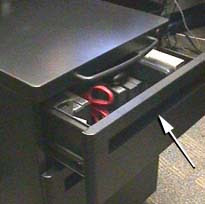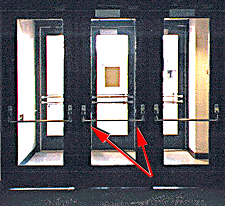[人因工程 ]
(2003/01/30)



Bad Designs: Video Rentals
A lot of video rental shops put their videos into these generic plastic boxes. This is to protect the video while it being rented out to people. I have problems putting the video back into the box correctly. The problem is that the videotape spools look like they are in the middle, but they are slightly closer to one edge than the other. And the box has little round protrusions that go into the spools.
The left picture shows the video oriented in the box wrong. That's what I frequently do. As a result, the box won't snap shut because the protrusions don't fit into the videotape spools. The right picture shows the tape in correctly.
Design Recommendations:
Why does the box need those protrusions anyway? If they were removed, the tape could fit into the box four different ways instead of just one. Of course, it would come out of the box four different ways too. That might be problem for the video shop people trying to read the labels on the videotapes.
Here are a few things that might make it easier for people to put the tape into the box the way the video people want it:
-- A line drawing of a videotape in the correct orientation "printed" on the inside of the box
-- A message like "Label this way" printed on the inside of the box
Editor's Comments:
One of my architecture professors at Rice University used to refer to this kind of design defect as "almost, but not quite". It was an apt formulation. The protrusions inside a standard plastic VHS videocassette box are "almost, but not quite" in the center. The problem of course originates with the design of the VHS cassette itself, but might have been remedied with some clever design of the outer case.
We have all at one time or another used cardboard, wood, plastic, or metal containers with rectangular lids. Occasionally these lids are "almost, but not quite" square. Lids that are obviously rectangular -- with a length to width ratio of 5 to 3 or more, are no problem. One can clearly see how they should be oriented in order to reseal their respective containers. It's the lids that are "almost, but not quite" square -- say 11 to 10, that artificially generate endless, unnecessary inconvenience.
I can hear some people groaning already. "Oh please, stop with the nitpicking. What's the big deal? Is anyone's life going to be endangered by this design defect?" Of course not. But if it wasn't such a big deal, if it was such a trivial matter, why wasn't it properly dealt with before it went into mass production? Before a defective layout on some draftsman's CAD screen was replicated in plastic a billion times over?
Here is where bad industrial design is worse than bad architectural design. A bad architectural design usually only gets built once, in a single location. If you don't have to live near the building, work in it, or visit it, you don't have to put up with its design defects. Bad product design on the other hand, gets reproduced billions of times and finds its way into our living rooms, by which time it's too late.
-- Bevin Chu
Explanation: Bad Designs: Video Rentals
Illustration: Video Rentals
Author: Michael J. Darnell
Affiliation: Bad Human Factors Designs
Source: www.baddesigns.com
Publication Date: 1998-1999
Original Language: English
Editor: Bevin Chu, Registered Architect












